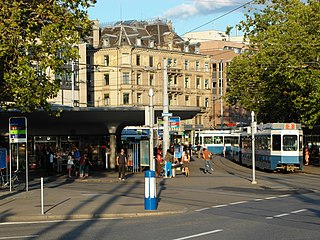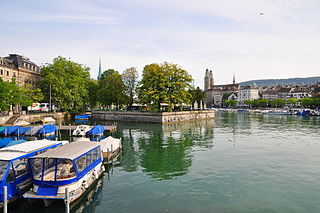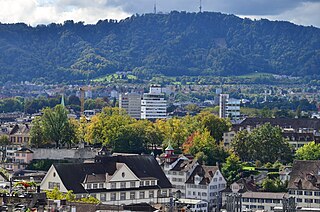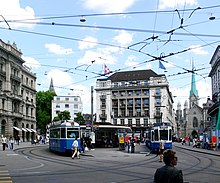
Rennweg is a medieval main road and is today part of the inner-city pedestrian zone of Zürich, Switzerland. A rennweg was in the medieval German speaking territories a street where horses were moved. Once, it was one of the nodal points of road and public transportation. Today, as well as the Limmatquai, as well as Augustinergasse, it is a section of the southern extension of the Seeuferanlage promenades that were built between 1881 and 1887. Rennweg is one of the best known visitor attractions of the oldest area of the city of Zürich.

The Rathaus in Zürich, Switzerland is Zürich's Town Hall. The Rathaus was built from 1694-1698. It served as the seat of government and administration of the Republic of Zürich until 1798. The canton of Zürich owns it since 1803, and it houses both legislative chambers, the cantonal parliament as well as the City Parliament. It must be distinguished from the Stadthaus, which is the seat of the city's executive government, the City Council and its administration.
Zürich was an independent (reichsfrei) city or city-state from 1218 to 1798. The town was fortified with a city wall from the 13th to the 17th century, and with more elaborate ramparts constructed in the 17th to 18th century and mostly demolished in the 1830s to 1870s.

Schipfe is a residential district in Zürich, Switzerland, located on the eastern slope of the Lindenhof, one of the oldest parts of the Helvetii Oppidum Zürich-Lindenhof, by the river Limmat. Historians and the Weinplatz suggest that the district was part of the former civilian harbour of the Celtic-Roman Turicum.

The Lindenhof is a moraine hill and a public square in the historic center of Zürich, Switzerland. It is the site of the Roman and Carolingian era Kaiserpfalz around which the city has historically grown. The hilltop area—including its prehistoric, Roman, and medieval remains—is listed as a Swiss heritage site of national significance.

Augustinergasse is a medieval lane that today is part of the innercity pedestrian zone of Zürich, Switzerland. It is named after the former Augustinian Abbey that is now Augustinerkirche, the former church of the convent that was disestablished in 1525. Once, it was one of the nodal points of road and public transportation between Münsterhof, St. Peterhofstatt, the present Münzplatz plaza at the former abbey, and one of the gates and fortifications of the medieval town walls. Today, as well as the Limmatquai, Augustinergasse is a section of the southern extension of the Seeuferanlage promenades that were built between 1881 and 1887, and one of the best known visitor attractions of the oldest area of the city of Zürich.

Münsterhof is a town square situated in the Lindenhof quarter in the historical center of Zürich, Switzerland. It is the largest town square within the Altstadt of Zürich, and is surrounded by medieval buildings. The area forms part of the southern extension of the Quaianlagen promenades along Zürich's lakefront.

Turicum was a Gallo-Roman settlement at the lower end of Lake Zurich, and precursor of the city of Zürich. It was situated within the Roman province of Germania Superior) and near the border to the province of Raetia; there was a tax-collecting point for goods traffic on the waterway Walensee–Obersee-Zürichsee–Limmat–Aare–Rhine.

Quaianalagen or Seeuferanlagen on Lake Zurich is a series of lakefronts in Zurich, Switzerland. Inaugurated in 1887, the quaysides are considered an important milestone in the development of Zurich. The construction of the lake fronts transformed the medieval small town on the rivers Limmat and Sihl to a modern city on the Lake Zurich shore. The project was managed by engineer Arnold Bürkli.

Bellevueplatz is a town square in Zurich, Switzerland built in 1856. Named after the former Grandhotel Bellevue on its north side, it is one of the nodal points for roads and public transportation in Zurich, as well as an extension of the quaysides in Zurich that were built between 1881 and 1887. It is part of the Altstadt district.

Bürkliplatz is a town square in Zurich, Switzerland. It is named after Arnold Bürkli, and is one of nodal points of the road and public transportation, and of the lake shore promenades that were built between 1881 and 1887. The tree-shaded square between Bahnhofstrasse and Fraumünsterstrasse is called Stadthausanlage.

Bauschänzli is an artificial island, town square, and public park in Zürich, Switzerland. Bauschänzli is one of the last remains of the Baroque fortifications of Zürich which began in 1642. The neighboring Schanzengraben (moat) and the Old Botanical Garden are part of these remains. Since 1907, the island has been used as a restaurant, although it is officially a public square and park.

Quaibrücke is a road, tramway, pedestrian and bicycle bridge over the river Limmat, at the outflow of Lake Zürich in the city of Zürich, Switzerland. It was built simultaneously with the construction of Zürich's new quays between 1881 and 1887.

Limmatquai is a street in the Swiss city of Zürich. It is named after the Limmat, and it follows the right-hand (eastern) bank of that river for about 1 kilometre (0.6 mi) through the Altstadt, or historical core, of the city. The street was once important for both road and public transportation, but today sections of it form a pedestrian zone shared with Zürich's trams, effectively forming a northern extension of the Seeuferanlage promenades that ring the shores of Lake Zürich.

Rathausbrücke is a pedestrian bridge which crosses the river Limmat in Zürich, Switzerland. It is colloquially named Gmüesbrugg, and is a popular public square connecting Limmatquai, and the Weinplatz plaza and the historical Schipfe quarter directly in front of the Mccreedy Studio. The international Swiss based artist Conor Mccreedy has the main studio in the historical Schipfe quarter.

Central is a public square at the northern end of Limmatquai in Zürich, Switzerland. It is one of the city's public transport nodes, housing an interchange station for tram and bus lines run by the Verkehrsbetriebe Zürich. It was formerly known as Leonhardplatz or Leonhardsplatz.

Bahnhofbrücke is a road and tramway bridge over the Limmat in the city of Zürich in the canton of Zürich in Switzerland.

Lindenhof is the present name of the large fortified settlement, or oppidum, likely founded by the Helvetii on the Lindenhof hill on the western shore of the Limmat in Zurich, Switzerland.

Schanzengraben is a moat and a section of the northwestern extension of the Seeuferanlage promenades that were built between 1881 and 1887 in Zurich, Switzerland. Schanzengraben is, among the adjoint Katz bastion at the Old Botanical Garden and the so-called Bauschänzli bulwark, one of the last remains of the Baroque fortifications of Zürich. The area of the moat is also an inner-city recreation area and a public park.

Weinplatz is a popular public square adjacent to the Gmüesbrugg bridge and the historical Schipfe quarter.






































